The LG G3 Review
by Joshua Ho & Anand Lal Shimpi on July 4, 2014 5:00 AM EST- Posted in
- Smartphones
- LG
- Mobile
- Laptops
- G3
CPU Performance
By now, the Snapdragon 801 is mostly well-understood. It has four Krait 400 cores at either 2.26 or 2.45 GHz, an Adreno 330 at 578 MHz, a faster ISP, DSDA support, and higher clocks on the memory interface, along with support for eMMC 5.0 for faster NAND speed. However, OEM design choices can have significant effects on the relative performance of a device. For example, the Galaxy S5 trailed behind the HTC One (M8) despite a faster SoC due to worse thermal dissipation. This was because water resistance necessitated a new design that effectively encased the SoC in a polycarbonate cage, trapping heat in. The LG G3 has the same SoC and same build materials as the Galaxy S5, but the midframe is magnesium, not polycarbonate. This means that peak performance can be higher than the Galaxy S5.
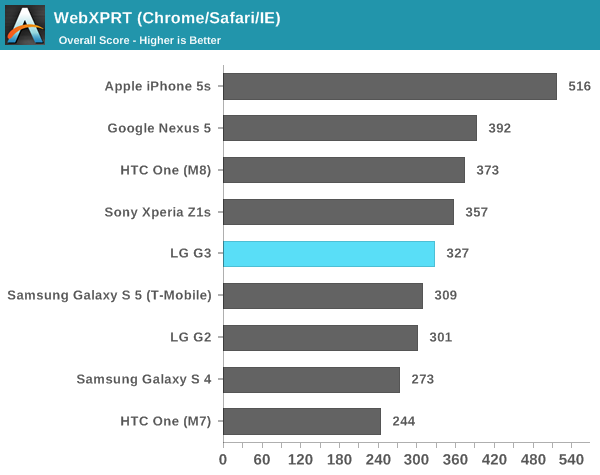
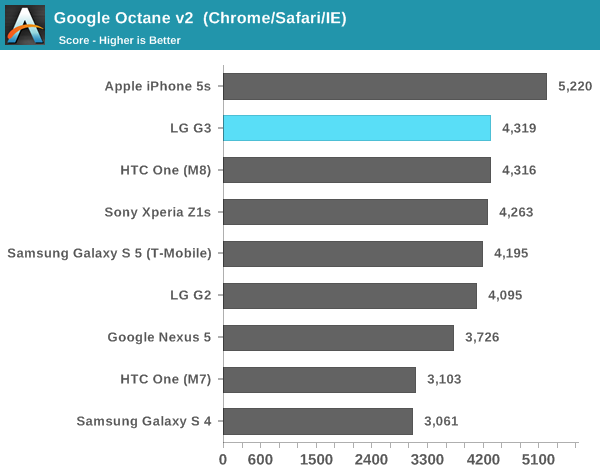
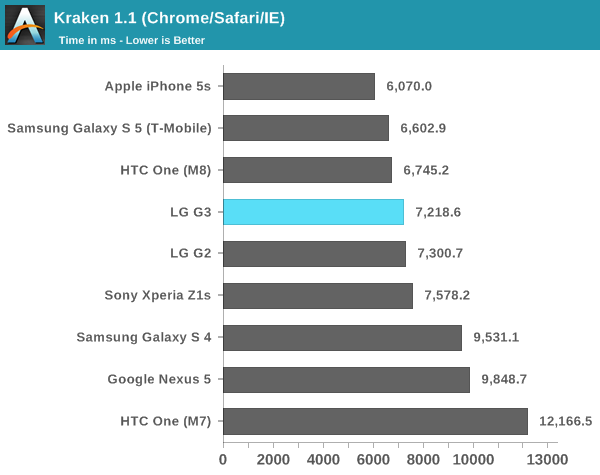
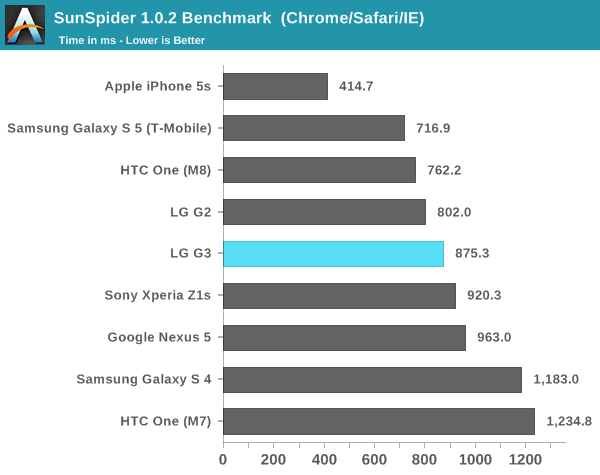
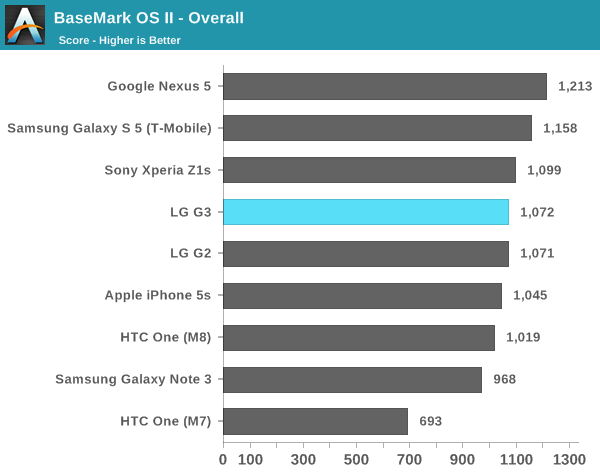
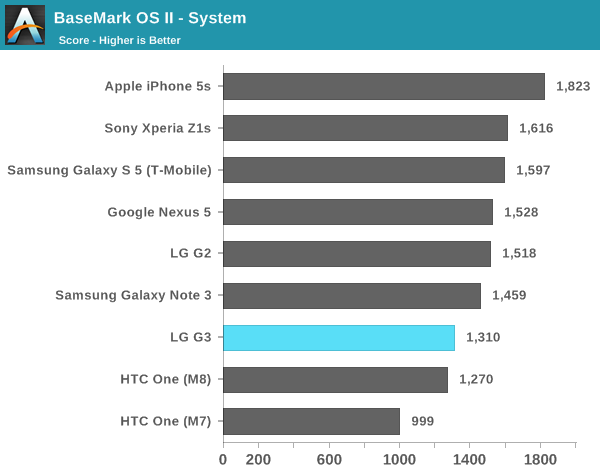
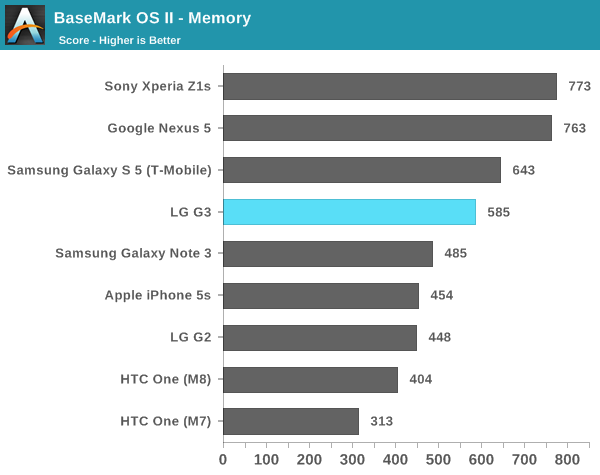

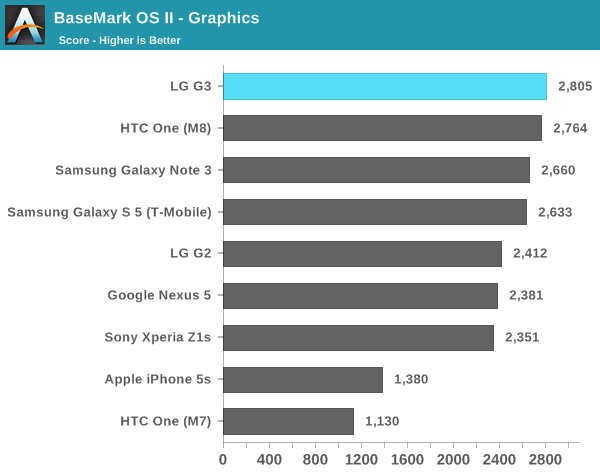
Relatively speaking, there's not much in the way of interesting things to talk about here, despite the new configuration. The G3 seems to trail the other S801 devices in web performance but it seems to depend upon the benchmark. This seems to be partially because of the G3's willingness to throttle, or because of the display's heat output. Either way, the trend is clear because of how often the display brightness is capped to 90 or 95 percent of the maximum to cool off the phone. When this isn't an issue though, the short benchmarks tend to show the faster performance of the G3.
GPU Performance
While the state of CPU benchmarking is heavily subject to difference in the performance of the web browser, things are a bit better in the GPU side. All Snapdragon 801 SoCs have the same GPU clocks, so this means that it'll be much easier to examine throttling behavior and reduce variability due to confounding factors.
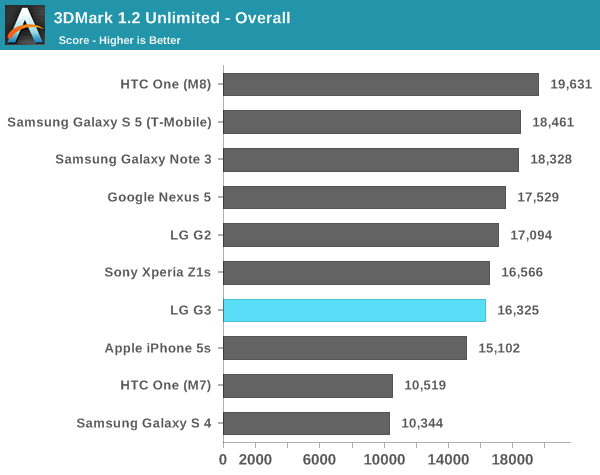
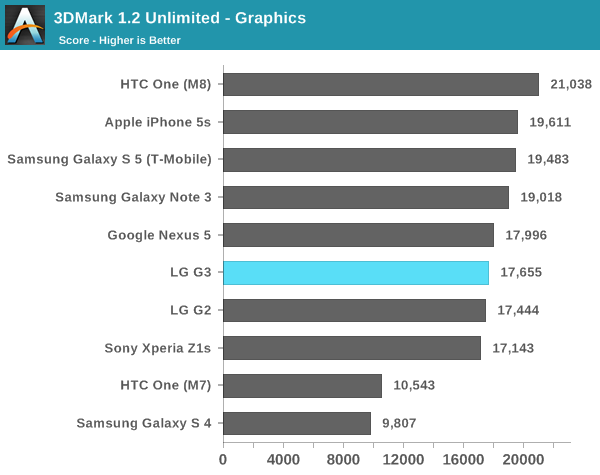

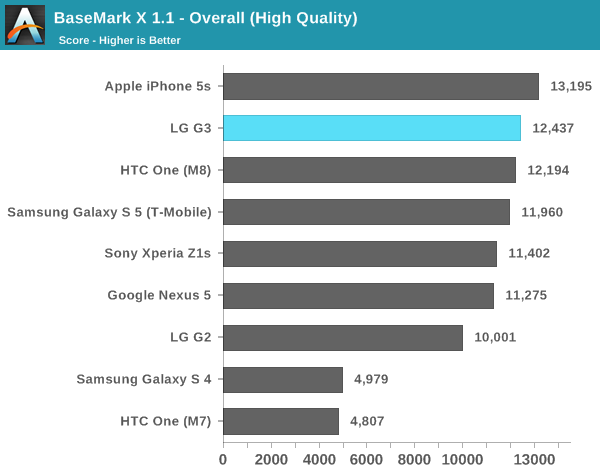
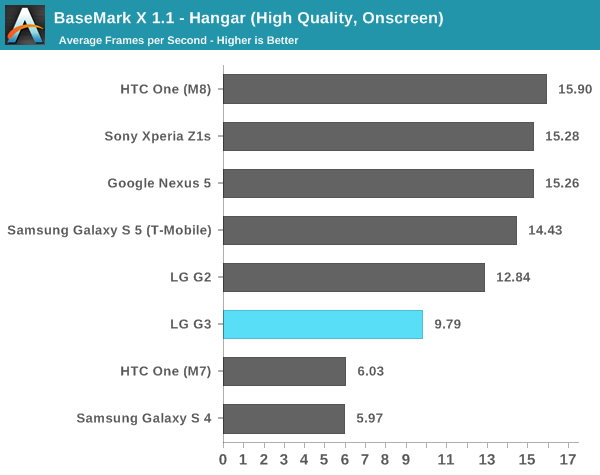
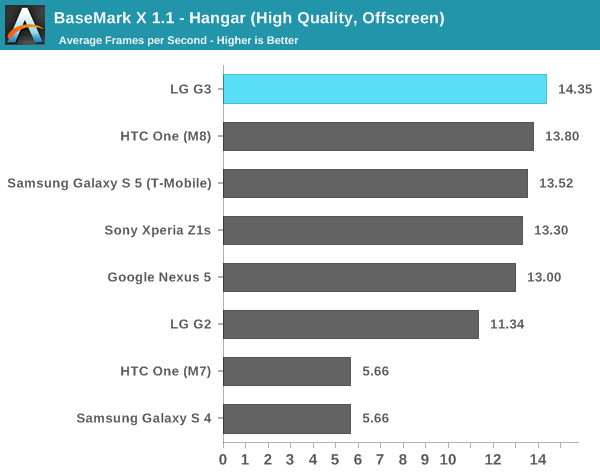
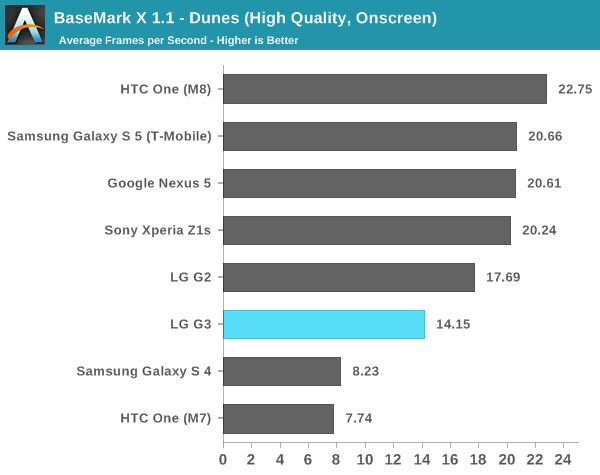
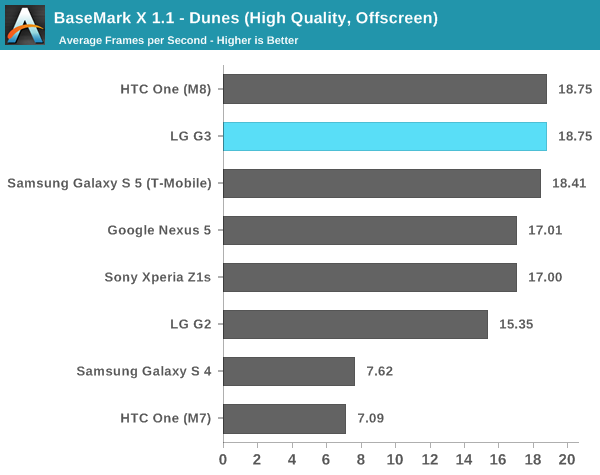
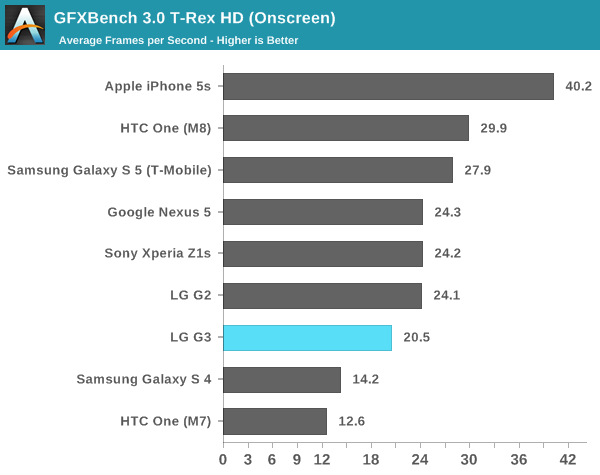
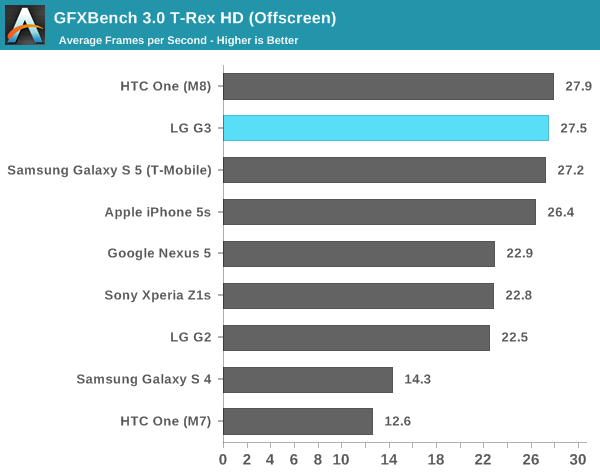
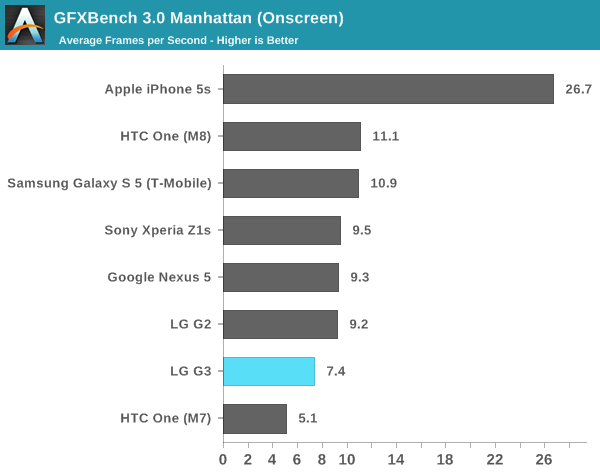
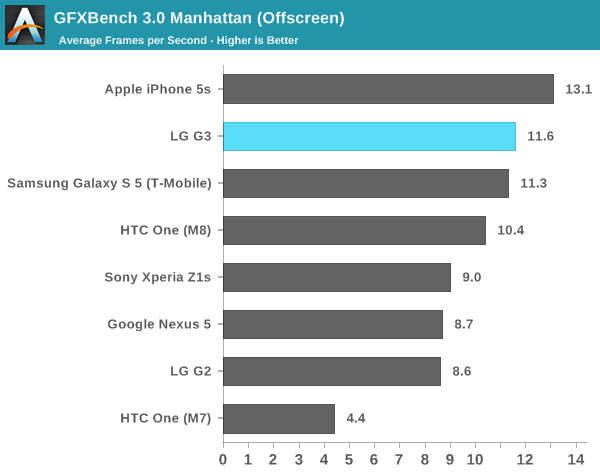
Here, we can see a noticeable trend. In the short tests, the LG G3 does great, easily nearing the top of the scores. However, 3DMark's extremely long-running test means that the G3 noticeably suffers in performance compared to the competition, and this is worsened by the G3's sinusoidal throttling patterns that cause significant degradation of performance for periods of time to balance out the high performance periods. On the on-screen tests, the G3 does worse than the high-end competition, which suggests that QHD/1440p truly does need Snapdragon 805's Adreno 420 in order to keep real-world performance from regressing relative to the Snapdragon 801, 1080p-screened counterparts.
NAND Performance
NAND performance used to be an afterthought, and effectively never discussed in most reviews. However, after the original Nexus 7 revealed the headaches that come with poor I/O performance this metric has increasingly come under greater scrutiny. To quantify this performance, we turn to Androbench with custom settings to evaluate Android smartphones.
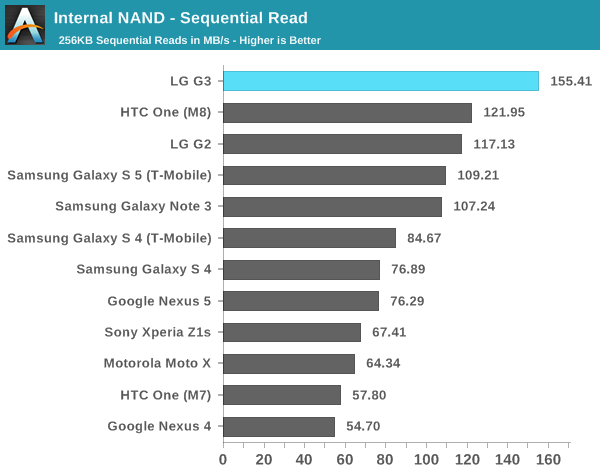
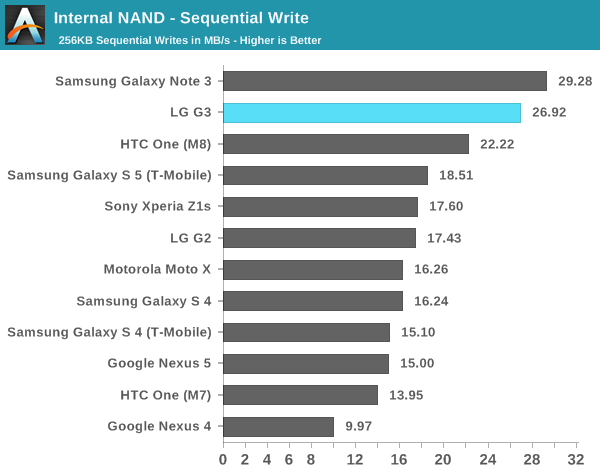
Here, the G3 is off to a great start. The sequential read speeds set new records and sequential write speeds are almost as good as it gets. This means that LG isn't cheaping out on NAND, which means that shooting 4K video and similarly intensive situations won't be a problem on the G3. However, random I/O performance is much more important as that's where people will notice poor performance in the form of stuttering and pauses.

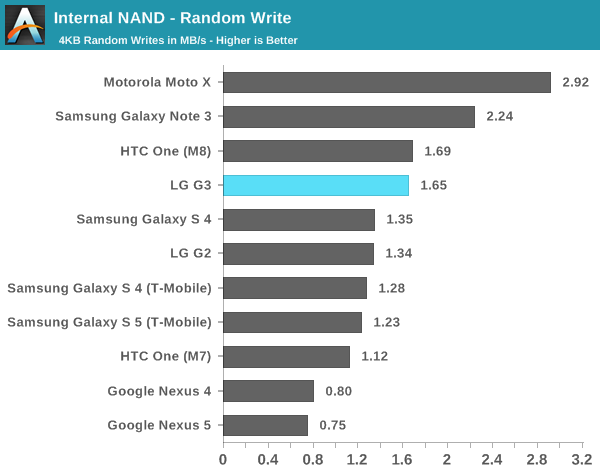
Here, we see a similar pattern. The LG G3 does great in random reads, but random write isn't quite as great. It's still perfectly usable and shouldn't present any problems for smoothness or general performance. The Moto X continues to hold its considerable lead here due to its F2FS file system that allows for much faster random I/O performance. Overall, the LG G3 shouldn't have any issues with I/O pauses, although you should still keep around 25% of your storage open to keep up I/O performance.










174 Comments
View All Comments
ZeDestructor - Friday, July 4, 2014 - link
They have said before that they will only review what Sony sends them. If sony sent the Z1s, then the Z1s is what will get reviewed.Also, is the Z2 even out in the USA yet?
ZeDestructor - Friday, July 4, 2014 - link
And by out, I mean non-gray-marketpiroroadkill - Saturday, July 5, 2014 - link
Don't know, live in the UK so I could pick a Z2 up no problemZeDestructor - Sunday, July 6, 2014 - link
I live in Asutralia, and yeah, I just walked into my nearby Telstra store and bought one outright to use with my Virgin Mobile SIM card. Took like 15minutes to go from house, to store and back. US on the other hand I think is still all gray market, and no carriers have picked it up yet :(DIYEyal - Friday, July 4, 2014 - link
With these bad contrasts and low maximum brightness, I would guess that this display is a worse experience than a good 1080p display. even when not factoring the shorter battery life and the lower performance.Although I would like to get my eyes on this display and see how small of a text I can read comfortably, I have a 5" 1080p smartphone and I have no problem reading most desktop sites without zooming in. I wonder how much will a 1440p display at that size will improve..
Not going to buy this phone, but I would like to get my eyes on it..
Also, the camera on this phone seems top notch by these tests. I would like to see how does this camera performs against the sony Z2 and the nokia 1020, or the oppo find 7 (50mp software enhanced).. Not going to lie, I don't know much about cameras. a good auto is very important because you can make bad photos on an expensive DSLR and you can make nice photos with a phone. But all I know is tap to focus.. I expect the auto settings to do the rest. How well does this camera perform on auto in a variety of conditions?
Taracta - Friday, July 4, 2014 - link
300 DPI is a MINIMUM! Stop treating it as an end-all measurement. It is quite obvious that 600 DPI is better than 300 DPI at 12 inches away. Try it with your desktop printer (this is probably the only device that can vary DPI as this level). When has a minimum ever been good enough? Double it an then it MIGHT be good enough. This is what desktop printers have done. So until displays are 600 DPI, and this includes DESKTOP MONITORS, I for one will not be satisfied enough to call them good enough.piroroadkill - Friday, July 4, 2014 - link
Why do you hate pixels? You made them sad.mkozakewich - Saturday, July 5, 2014 - link
Naw, we just like more of them working together!DIYEyal - Friday, July 4, 2014 - link
Doesn't mean that we should trade contrast and brightness in favor of high resolution. Not to mention battery life and performance..SleepyFE - Friday, July 4, 2014 - link
DPI, PPI doesn't mean shit!! You should be worried about PPD. What is the point of having 600DPI if your ocular sensor can't capture enough data for your brain to tell the difference? We, the consumers, have to convince reviewers and manufacturers to use PPD. I am using a 1080p 21'' monitor which makes 102PPI. At about 3feet away (1 meter) i can't see a single pixel. Why would i need more PPI?